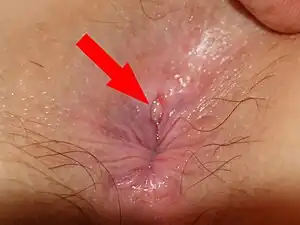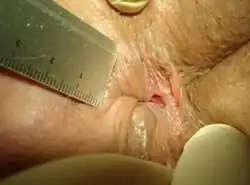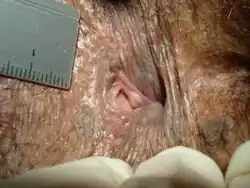Anal fissure
| Anal fissure | |
|---|---|
| Other names: Fissure in ano, rectal fissure | |
 | |
| An anal fissure | |
| Specialty | General surgery |
| Symptoms | Severe pain with bowel movements, rectal bleeding[1] |
| Complications | Anal fistula, fecal incontinence[1] |
| Duration | Few days to few weeks[1] |
| Types | Primary, secondary[1] |
| Causes | Constipation, diarrhea, sexually transmitted infections, inflammatory bowel disease, childbirth, HIV/AIDS, anal cancer, anal sex[1] |
| Diagnostic method | Based on symptoms and examination[1] |
| Differential diagnosis | Hemorrhoids, perianal abscess, anal fistula[1] |
| Prevention | Sufficient fluid intake[1] |
| Treatment | Sitz baths, pain medication, stool softeners, high-fiber diet, surgery[1] |
| Medication | Glyceryl trinitrate, nifedipine, botox[2] |
| Frequency | Common[1] |
An anal fissure is a break or superficial tear in the skin of the anal canal.[1] Symptoms generally include severe pain with bowel movements and potentially small amounts of rectal bleeding.[1] The pain may last for hours after a bowel movement.[1] They can reoccur and last for more than 6 weeks.[1] Complications may include anal fistula formation and fecal incontinence.[1]
Common causes include constipation and injury.[1] Other causes include diarrhea, sexually transmitted infections, inflammatory bowel disease, childbirth, HIV/AIDS, anal cancer, and anal sex.[1] They typically occur in the midline posteriorly.[1] Diagnosis is generally based on symptoms and examination.[1]
Initial treatment is often with sitz baths, pain medication, stool softeners, and a high-fiber diet.[1] Other medications that may be used include glyceryl trinitrate or nifedipine applied to the skin or botox injections.[2] If this is not effective surgery, known as a lateral internal sphincterotomy, may be performed.[3] They are common both in children and adults.[1] Males and females are affected equally.[1] The condition was initially described by John Lockhart-Mummery in 1934.[3]
Signs and symptoms
Symptoms generally include severe pain with bowel movements and potentially small amounts of rectal bleeding.[1] The pain may last for hours after a bowel movement.[1] They can occur recurrently and last for more than 6 weeks.[1]
Fissures may develop a hood like skin tag (sentinel piles).[1]
Causes
Most anal fissures are caused by stretching of the anal mucous membrane beyond its capability.[5]
Superficial or shallow anal fissures look much like a paper cut, and may be hard to detect upon visual inspection; they will generally self-heal within a couple of weeks. However, some anal fissures become chronic and deep and will not heal. The most common cause of non-healing is spasming of the internal anal sphincter muscle which results in impaired blood supply to the anal mucosa. The result is a non-healing ulcer, which may become infected by fecal bacteria. In adults, fissures may be caused by constipation, the passing of large, hard stools, or by prolonged diarrhea. In older adults, anal fissures may be caused by decreased blood flow to the area. When fissures are found laterally, tuberculosis, occult abscesses, leukemic infiltrates, carcinoma, acquired immunodeficiency syndrome (AIDS) or inflammatory bowel disease should be considered as causes.[6] Some sexually transmitted infections can promote the breakdown of tissue resulting in a fissure. Examples of sexually transmitted infections that may affect the anorectal area are syphilis, herpes, chlamydia and human papilloma virus.[7]
Other common causes of anal fissures include:
- childbirth trauma in women[8]
- anal sex[9][10]
- Crohn's disease[8]
- ulcerative colitis[11]
- poor toileting in young children.[12]
Prevention
For adults, the following may help prevent anal fissures:
- Avoiding straining when defecating. This includes treating and preventing constipation by eating food rich in dietary fiber, drinking enough water, occasional use of a stool softener, and avoiding constipating agents.[13] Similarly, prompt treatment of diarrhea may reduce anal strain.
- Careful anal hygiene after defecation, including using soft toilet paper and cleaning with water, plus the use of sanitary wipes.
- In cases of pre-existing or suspected fissure, use of a lubricating ointment (It is important to note that hemorrhoid ointment is contraindicated because it constricts small blood vessels, thus causes a decrease in blood flow, which prevents healing.)
In infants, frequent diaper change can prevent anal fissure. As constipation can be a cause, making sure the infant is drinking enough fluids (i.e. breastmilk, proper ratios when mixing formulas) is beneficial. In infants, once an anal fissure has occurred, addressing underlying causes is usually enough to ensure healing occurs.
Treatment
Non-surgical treatments are recommended initially for acute and chronic fissures.[14][15] These include topical nitroglycerin or calcium channel blockers (e.g. diltiazem), or injection of botulinum toxin into the anal sphincter.[16]
Other measures include warm sitz baths, topical anesthetics, high-fiber diet and stool softeners.[17][18]
Medication
Local application of medication to relax the sphincter muscle, thus allowing the healing to proceed, was proposed in 1994 with nitroglycerine ointment,[19][20][21][22] and calcium channel blockers in 1999 with nifedipine ointment,[23][24] and the following year topical diltiazem.[25] These improve healing from about 40% to 60% at 8 weeks.[26]
Branded preparations are available of topical nitroglycerine ointment as 0.2% in Australia and 0.4% in UK and US[27]), topical nifedipine 0.3% with lidocaine 1.5% ointment and diltiazem 2%. A common side effect of nitroglycerine ointment is headache.[26]
Direct injection of botulinum toxin (Botox) into the anal sphincter may be carried out. This treatment was first investigated in 1993. However, in many cases Botox injections become less effective. Lateral sphincterotomy is the gold standard for cure.[28] Combination of medical therapies may offer up to 98% cure rates.[29] Some evidence also supports the use of vitamin E cream.[26]
Surgery
Surgical procedures are generally reserved for people with anal fissure who have tried medical therapy for at least one to three months and have not healed. It is not the first option in treatment.
The main concern with surgery is the development of anal incontinence. Anal incontinence can include inability to control gas, mild fecal soiling, or loss of solid stool. Some degree of incontinence can occur in up to 45 percent of patients in the immediate surgical recovery period. However, incontinence is rarely permanent and is usually mild. The risk should be discussed with one's surgeon.
Surgical treatment, under general anaesthesia, was either anal stretch (Lord's operation) or lateral sphincterotomy where the internal anal sphincter muscle is incised. Both operations aim to decrease sphincter spasming and thereby restore normal blood supply to the anal mucosa. Surgical operations involve a general or regional anaesthetia. Anal stretch is also associated with anal incontinence in a small proportion of cases and thus sphincterotomy is the operation of choice.
Sphincterotomy
Lateral internal sphincterotomy (LIS) is the surgical procedure of choice for anal fissures due to its simplicity and its high success rate (~95%). In this procedure the internal anal sphincter is partially divided in order to reduce spasming and thus improve the blood supply to the perianal area. This improvement in the blood supply helps to heal the fissure, and the weakening of the sphincter is also believed to reduce the potential for recurrence. The procedure is generally performed as a day surgery after the patient is given general anesthesia. The pain from the sphincterotomy is usually mild and is often less than the pain of the fissure itself. Patients often return to normal activity within one week.
LIS does, however, have a number of potential side effects including problems with incision site healing and incontinence to flatus and faeces (some surveys of surgical results suggest incontinence rates of up to 36%).[30]
Though lateral internal sphincterotomy (LIS) is considered safe on short-term basis, there are concerns about its long-term safety. Pankaj Garg et al. published a systematic review and meta-analysis in which they analyzed the long-term continence disturbance two years after the LIS procedure. They found the incidence of long-term continence disturbance to be 14%, so caution and careful patient selection are needed before undergoing LIS.[31]
Dilation
Anal dilation, or stretching of the anal canal (Lord's operation), has fallen out of favour in recent years, primarily due to the unacceptably high incidence of fecal incontinence.[32] In addition, anal stretching can increase the rate of flatus incontinence.[33] The incidence of incontinence is thought to be due to a lack of standardization and that proper technique results in little chance that it will occur.[34]
In the early 1990s, however, a repeatable method of anal dilation proved to be very effective and showed a very low incidence of side effects.[35] Since then, at least one other controlled, randomized study has shown there to be little difference in healing rates and complications between controlled anal dilation and LIS,[36] while another has again shown high success rates with anal dilation coupled with low incidence of side effects.[37]
Epidemiology
The incidence of anal fissures is around 1 in 350 adults.[12] They occur equally commonly in men and women and most often occur in adults aged 15 to 40.[12]
History
Anal fissure was first described by John Lockhart-Mummery in Diseases of the Rectum and Colon and Their Surgical Treatment (1934).[3]
See also
References
- 1 2 3 4 5 6 7 8 9 10 11 12 13 14 15 16 17 18 19 20 21 22 23 24 25 26 Jahnny, B; Ashurst, JV (January 2020). "Anal Fissures". PMID 30252319.
{{cite journal}}: Cite journal requires|journal=(help) - 1 2 Nelson, RL; Thomas, K; Morgan, J; Jones, A (15 February 2012). "Non surgical therapy for anal fissure". The Cochrane database of systematic reviews (2): CD003431. doi:10.1002/14651858.CD003431.pub3. PMID 22336789.
- 1 2 3 Beaty, JS; Shashidharan, M (March 2016). "Anal Fissure". Clinics in colon and rectal surgery. 29 (1): 30–7. doi:10.1055/s-0035-1570390. PMID 26929749.
- 1 2 Kuehn, HG; Gebbensleben, O; Hilger, Y; Rohde, H (2009). "Relationship between anal symptoms and anal findings". International journal of medical sciences. 6 (2): 77–84. doi:10.7150/ijms.6.77. PMID 19277253. Archived from the original on 2021-01-22. Retrieved 2021-02-18.
- ↑ Madoff, Robert D.; Melton-Meax, Genevieve B. (2020). "136. Diseases of the rectum and anus". In Goldman, Lee; Schafer, Andrew I. (eds.). Goldman-Cecil Medicine. Vol. 1 (26th ed.). Philadelphia: Elsevier. p. 936. ISBN 978-0-323-55087-1. Archived from the original on 2023-03-17. Retrieved 2023-03-17.
- ↑ "Common Anorectal Conditions". American Academy of Family Physicians. Archived from the original on 5 August 2012.
- ↑ "Anal Fissure – Causes". NHS Choices. Archived from the original on 4 February 2013.
- 1 2 Collins, E. E.; Lund, J. N. (September 2007). "A Review of Chronic Anal Fissure Management". Techniques in Coloproctology. 11 (3): 209–223. doi:10.1007/s10151-007-0355-9. PMID 17676270.
- ↑ "What Causes Anal Fissures?". WebMD. Archived from the original on 27 July 2017. Retrieved 20 July 2017.
- ↑ Ferri, Fred F. (2015). Ferri's Clinical Advisor 2016. Elsevier Health Sciences. p. 108. ISBN 9780323378222.
- ↑ "Anal Fissure Treatment, Symptoms & Surgery - Cleveland Clinic: Health Library". Cleveland Clinic. Archived from the original on 22 August 2013.
- 1 2 3 "Anal Fissure – Basics – Epidemiology". Best Practice. British Medical Journal. 23 April 2012. Archived from the original on 27 August 2021. Retrieved 30 June 2012.
- ↑ Basson, Marc D. (28 January 2010). "Constipation". eMedicine. New York, NY: WebMD. Archived from the original on 15 February 2010. Retrieved 5 April 2010.
- ↑ Nelson RL, Thomas K, Morgan J, Jones A (2012). "Non surgical therapy for anal fissure". Cochrane Database of Systematic Reviews. 2: CD003431. doi:10.1002/14651858.CD003431.pub3. PMC 7173741. PMID 22336789.
- ↑ Haq., Z.; Rahman, M.; Chowdhury, R.; Baten, M.; Khatun, M. (2005). "Chemical Sphincterotomy—First Line of Treatment for Chronic Anal Fissure". Mymensingh Medical Journal. 14 (1): 88–90. PMID 15695964.
- ↑ Shao, WJ; Li, GC; Zhang, ZK (September 2009). "Systematic review and meta-analysis of randomized controlled trials comparing botulinum toxin injection with lateral internal sphincterotomy for chronic anal fissure". International journal of colorectal disease. 24 (9): 995–1000. doi:10.1007/s00384-009-0683-5. PMID 19266207.
- ↑ "Anal Fissure – Treatment Overview". WebMD. Archived from the original on 5 October 2011. Retrieved 27 September 2011.
- ↑ Poritz, Lisa Susan. "Anal Fissure Treatment & Management". Medscape. Archived from the original on 31 October 2011. Retrieved 27 September 2011.
- ↑ Loder, P.; Kamm, M.; Nicholls, R.; Phillips, R. (1994). "'Reversible Chemical Sphincterotomy' by Local Application of Glyceryl Trinitrate". British Journal of Surgery. 81 (9): 1386–1389. doi:10.1002/bjs.1800810949. PMID 7953427.
- ↑ Watson, S.; Kamm, M.; Nicholls, R.; Phillips, R. (1996). "Topical Glyceryl Trinitrate in the Treatment of Chronic Anal Fissure". British Journal of Surgery. 83 (6): 771–775. doi:10.1002/bjs.1800830614. PMID 8696736.
- ↑ Simpson, J.; Lund, J.; Thompson, R.; Kapila, L.; Scholefield, J. (2003). "The Use of Glyceryl Trinitrate (GTN) in the Treatment of Chronic Anal Fissure in Children". Medical Science Monitor. 9 (10): PI123–126. PMID 14523338. Archived from the original on 2020-11-24. Retrieved 2022-03-15.
- ↑ Lund, J. N.; Scholefield, J.H. (4 January 1997). "A Randomised, Prospective, Double-blind, Placebo-controlled Trial of Glyceryl Trinitrate Ointment in Treatment of Anal Fissure". The Lancet. 349 (9044): 11–14. doi:10.1016/S0140-6736(96)06090-4. PMID 8988115.
- ↑ Antropoli, C.; Perrotti, P.; Rubino, M.; Martino, A.; De Stefano, G.; Migliore, G.; Antropoli, M.; Piazza, P. (1999). "Nifedipine for Local Use in Conservative Treatment of Anal Fissures: Preliminary Results of a Multicenter Study". Diseases of the Colon and Rectum. 42 (8): 1011–1015. doi:10.1007/BF02236693. PMID 10458123.
- ↑ Katsinelos, P.; Kountouras, J.; Paroutoglou, G.; Beltsis, A.; Chatzimavroudis, G.; Zavos, C.; Katsinelos, T.; Papaziogas, B. (2006). "Aggressive Treatment of Acute Anal Fissure with 0.5% Nifedipine Ointment Prevents Its Evolution to Chronicity". World Journal of Gastroenterology. 12 (38): 6203–6206. PMID 17036396. Archived from the original on 12 May 2009. Retrieved 12 May 2009.
- ↑ Carapeti, E.; Kamm, M.; Phillips, R. (2000). "Topical Diltiazem and Bethanechol Decrease Anal Sphincter Pressure and Heal Anal Fissures without Side Effects". Diseases of the Colon and Rectum. 43 (10): 1359–1362. doi:10.1007/BF02236630. PMID 11052511.
- 1 2 3 Ton, Joey (16 October 2022). "#325 Topical Anal Fissure Treatments – getting to the bottom of it". CFPCLearn. Archived from the original on 28 March 2023. Retrieved 14 June 2023.
- ↑ "Rectiv". drugs.com. Archived from the original on 2 September 2011. Retrieved 27 September 2011.
- ↑ Jost, W.; Schimrigk, K. (1993). "Use of Botulinum Toxin in Anal Fissure". Diseases of the Colon and Rectum. 36 (10): 974. doi:10.1007/BF02050639. PMID 8404394.
- ↑ Tranqui, P.; Trottier, D.; Victor, C.; Freeman, J. (2006). "Nonsurgical treatment of chronic anal fissure: nitroglycerin and dilatation versus nifedipine and botulinum toxin" (PDF). Canadian Journal of Surgery. 49 (1): 41–45. PMC 3207506. PMID 16524142. Archived (PDF) from the original on 6 January 2016. Retrieved 12 May 2009.
- ↑ Wolff, B. G.; Fleshman, J.W.; Beck, D. E.; Church, J. M. (2007). The ASCRS Textbook of Colon and Rectal Surgery. Springer. p. 180. ISBN 978-0-387-24846-2. Retrieved 15 July 2009.
- ↑ Garg P, Garg M, Menon GR (March 2013). "Long-term continence disturbance after lateral internal sphincterotomy for chronic anal fissure: a systematic review and meta-analysis". Colorectal Dis. 15 (3): e104–17. doi:10.1111/codi.12108. PMID 23320551.
- ↑ Becker, Horst Dieter (2005). Urinary and Fecal Incontinence: An Interdisciplinary Approach. Springer Science & Business Media. p. 105. ISBN 9783540222255. OCLC 185042351. Retrieved 17 August 2014.
- ↑ Sadovsky, R. (1 April 2003). "Diagnosis and management of patients with anal fissures – Tips from Other Journals". American Family Physician. 67 (7): 1608. Archived from the original (Reprint) on 29 January 2006. Retrieved 12 May 2009.
- ↑ Gupta PJ (2004). "Treatment of fissure in ano- revisited". Afr Health Sci. 4: 58–62. PMC 2141661. PMID 15126193.
- ↑ Sohn, N; Weinstein, M.A. (January 1997). "Anal dilatation for anal fissures". Seminars in Colon and Rectal Surgery. 8: 17–23. Archived from the original on 2018-07-28. Retrieved 2018-10-22.
- ↑ Yucel, T.; Gonullu, D.; Oncu, M.; Koksoy, F. N.; Ozkan, S. G.; Aycan, O. (June 2009). "Comparison of Controlled-intermittent Anal Dilatation and Lateral Internal Sphincterotomy in the Treatment of Chronic Anal Fissures: A Prospective, Randomized Study". International Journal of Surgery. 7 (3): 228–231. doi:10.1016/j.ijsu.2009.03.006. PMID 19361582.
- ↑ Renzi, A.; Brusciano, L.; Pescatori, M.; Izzo, D.; Napolitano, V.; Rossetti, G.; del Genio, G.; del Genio, A. (January 2005). "Pneumatic Balloon Dilatation for Chronic Anal Fissure: A Prospective, Clinical, Endosonographic, and Manometric Study". Diseases of the Colon and Rectum. 48 (1): 121–126. doi:10.1007/s10350-004-0780-z. PMID 15690668.
External links
| Classification | |
|---|---|
| External resources |
- Lund, J. N.; Nyström, P. O.; Coremans, G.; Herold, A.; Karaitianos, I.; Spyrou, M.; Schouten, W. R.; Sebastian, A. A.; Pescatori, M. (October 2006). "An evidence-based treatment algorithm for anal fissure". Techniques in Coloproctology. 10 (3): 177–180. doi:10.1007/s10151-006-0276-z. PMID 16969620.

